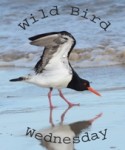Posted by: Ken @ 9:33 am
 Update on the Rosy-Finches of Sandia Crest, New Mexico. The flag is waving–
Update on the Rosy-Finches of Sandia Crest, New Mexico. The flag is waving–
smaller flocks of Rosy-Finches are still visiting the feeders at Sandia Crest House. No more banding, but feeders should remain up until the end of March unless bears appear.
Final Banding Session at Crest House
Last night, Nancy Cox waxed enthusiastic about today’s banding prospects. They had almost decided to cancel this last session. She said: “I spoke with Gene Jr. today and they saw a large flock of Rosy-Finches this morning when they put out fresh food. I wanted to confirm that the Crest House was going to be open tomorrow (Easter) and they will be. In fact they are thawing out the chicken for our quesadillas.”As a now-virtual New Mexican, this certainly stokes my nostalgia. The Crest House offers some great chile (yes, you Texans, that’s how it’s spelled in New Mexico!), whether red or green, in a bowl, on a burger, or atop a tortilla with chicken and cheese!
This evening I received this report, describing the final day of banding:
Date: March 23, 2008
From: Steve & Nancy Cox
Hi all,
We almost did not band today. However, with Steve Fettig’s persistence to get a few more photos we went to the Crest House one more time. We had to wait for about an hour before a flock of just over a hundred came into the feeder. We banded another 13 Rosy-Finches today. We caught and banded 2 more Hepburn’s (thanks to Cole), 4 more Gray-crowned Interiors and 7 more Brown-capped. We did recapture 13 Brown-capped and 2 Blacks but they were all from this season.
That brings us to a season total of 462 Rosy-Finches. Brown-capped were the most numerous - 295 new birds banded. We banded a total of 97 Gray-crowned (29 of which were Hepburn’s) and 70 Blacks.
Devin and Justin Bosler (from Louisiana) counted at least 115 Rosy-Finches in the flock and that was while we had some in hand. Gene Romero had promised us a large flock and he was right.
Thanks again to our wonderful banding team. You made it another successful year and we are looking forward to next year when we have radio transmitters to place on these gorgeous birds. We will miss them.
Nancy & Steve
Click here to view the team’s spreadsheet that contains the entire season’s banding data, and summarizes all banding since the research program began in 2004. (requires Excel or Free Excel Viewer, available at this link).
Radar Drama: Migrants vs. Storms
Yesterday afternoon, the front that had stalled to our south began moving north, giving us some heavy rain here in South Florida. Behind it, conditions were favorable for migrants to once again venture northward across the Florida Straits. Today, that same front is expected to retreat and cross over us again, not only giving us more storms, but also shifting the winds to northerlies for the next couple of days. Depending upon the timing of these events, they could produce a fallout of migrants. So far, ground observations have not indicated an influx of migrants, despite abundant radar images. As it normally takes only 3 to 4 hours for migrants to cross the Straits, they presumably can overfly South Florida well before dawn, when they settle down.At around 9 PM last night, the Key West radar showed what looked like northbound migrants beginning to leave the north coast of Cuba as well as the western Keys.
Again, I must emphasize that these interpretations, however
dramatic they appear, must be subject to the review of experts. As I have
mentioned, “My Son the Meteorologist” is in the field, working on fire
weather and I did not want to bother him for assistance. When he does get a chance to read this, he may tell me I am “all wet.” [But see his subsequent COMMENT, below]
BADBIRDZ2 should be back
from New Zealand in a couple of days and will begin providing his own
analysis! [These loops requires Java and may load slowly– see the NOTE below about adjusting your Java settings.] THESE ARCHIVED IMAGES WILL EXPIRE AFTER ABOUT 6 DAYS
This is a two hour loop, from 10 to midnight. Last night: SORRY LINKS ARE INACTIVE AFTER A FEW DAYS
![]()
This second two hour loop. from midnight to 2 AM this morning, appears to show large numbers of birds crossing the Keys. (I say “appears” in hopes that BADBIRDZ2 or another expert will validate my observation).
![]()
The next 2 hour loop, from 2:00 to 4:00 am shows the eastern leading edge of the flock reaching Miami-Dade County, with about 2/3 of the flock over open waters, as another weather system approaches from the west. These birds appear to be on a collision course with the storms. The echoes from the birds appear to be part of the “ground clutter” around the Key West radar, but there is definite northward movement as they approach the northern limits of detection.
I tried for one more loop to see what happened to the westernost part of the flock, that seemed to be in peril. They actually continue streaming northwestward into the Gulf of Mexico, at a right angle to the advancing storms. This loop is from 4:00 to 6:00 AM this morning:
NOTE: If you have trouble viewing these loops, you may need to adjust your Java runtime parameters and possibly your virtual memory allocations. The (easily followed) instructions for PCs and Mac’s as well as Linux systems are provided at the top of the radar display.












